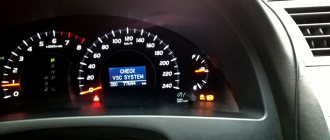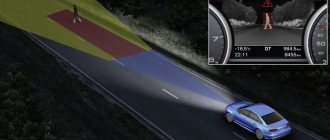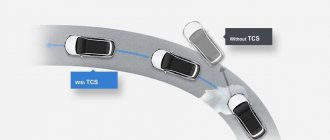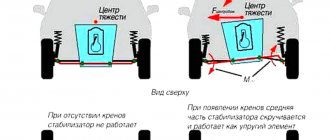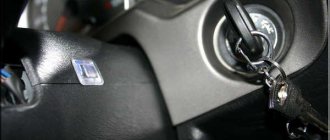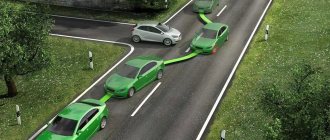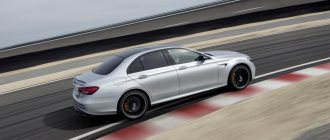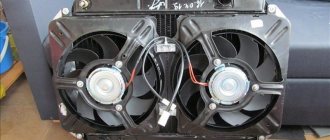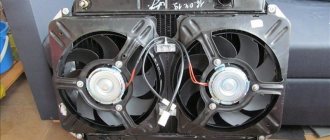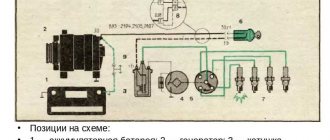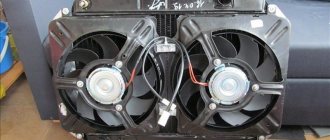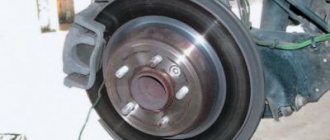The ESC exchange rate stability system is an electro-hydraulic active safety system, the main purpose of which is to prevent the car from skidding, that is, to prevent deviation from the specified trajectory during sharp maneuvering. ESC has another name - “dynamic stabilization system”. The abbreviation ESC stands for Electronic Stability Control - electronic stability control (ECU). The stabilization system is a comprehensive system that covers the capabilities of ABS and TCS. Let's consider the principle of operation of the system, its main components, as well as the positive and negative aspects of operation.
How the system works
Let's look at the principle of ESC operation using the example of the ESP (Electronic Stability Program) stability control system from Bosch, which has been installed on cars since 1995.
ESC stabilizes the car's position when skidding
The most important thing for ESP is to correctly determine the moment of an uncontrollable (emergency) situation. While driving, the stabilization system continuously compares the vehicle's movement parameters and the driver's actions. The system begins to work if the actions of the person behind the wheel become different from the actual parameters of the car’s movement. For example, a sharp turn of the steering wheel at a large angle.
An active safety system can stabilize a vehicle's motion in several ways:
- braking certain wheels;
- changing engine torque;
- changing the angle of rotation of the front wheels (if an active steering system is installed);
- changing the degree of damping of the shock absorbers (if adaptive suspension is installed).
The exchange rate stability system prevents the car from going beyond the specified turning path. If the sensors detect understeer, ESP brakes the rear inner wheel and also changes the engine torque. If oversteer is detected, the system brakes the front outer wheel and also varies the torque.
To brake the wheels, ESP uses the ABS system on which it is based. The work cycle includes three stages: increasing pressure, maintaining pressure, releasing pressure in the brake system.
The engine torque is changed by the dynamic stabilization system in the following ways:
- canceling gear changes in an automatic gearbox;
- missed fuel injection;
- changing the ignition timing;
- changing the throttle position angle;
- misfire;
- redistribution of torque along the axles (on vehicles with all-wheel drive).
Pros and cons of ESP and ESC
Like any system aimed at improving something, the exchange rate stability system has its advantages and disadvantages.
The main advantages are:
- Makes it possible to maintain vehicle stability and move within a given trajectory;
- Maintaining vehicle controllability in bad weather conditions and preventing the vehicle from tipping over;
- Vehicle collision prevention;
- Greater controllability, maneuverability and flexibility of the car on the road and stabilization of the road train;
- Creates a third driver-controlled dimension.
The system prevents enough skidding, which is a major factor in serious accidents and accidents resulting in death or irreparable harm to health.
The disadvantages include:
- The system can be turned off, which is used by extreme drivers.
- The system can show extremely poor performance at high speeds and at small turning radii.
Device and main components
The exchange rate stability system is a collection of simpler systems: ABS (prevents brake locking), EBD (distributes braking forces), EDS (electronically locks the differential), TCS (prevents wheel slip).
Components of the exchange rate stability system: 1 – hydraulic unit with ECU; 2 – wheel speed sensors; 3 – steering angle sensor; 4 – linear and angular acceleration sensor; 5 – electronic engine control unit
The dynamic stabilization system includes a set of sensors, an electronic control unit (ECU) and an actuator - a hydraulic unit.
Sensors monitor certain vehicle movement parameters and transmit them to the control unit. Using sensors, ESC evaluates the actions of the person behind the wheel, as well as the driving parameters of the car.
To evaluate the actions of a person behind the wheel, the stability control system uses brake pressure and steering angle sensors, as well as a brake light switch. Vehicle movement parameters are monitored by sensors of pressure in the brake system, wheel speed, angular velocity of the vehicle, longitudinal and lateral acceleration.
Based on the data received from the sensors, the control unit generates control signals for the actuators of the systems that are part of the ESC. Commands from the ECU receive:
- anti-lock braking system intake and exhaust valves;
- high pressure valves and traction control switching valves;
- ABS, ESP and brake system warning lamps.
During operation, the ECU interacts with the automatic transmission control unit, as well as with the engine control unit. The control unit not only receives signals from these systems, but also generates control actions for their elements.
ESC is part of a comprehensive car safety system
An early form of ESC was first introduced by Toyota with their "anti-skid" system. It wasn't until the late 80s and early 90s that ESC became standardized and more manufacturers began installing it in their cars. BMW, Toyota, Mercedes-Benz were the pioneers who started working with this system.
Anti-lock braking system (ABS) is also part of this, as are monitoring technologies that help prevent accidents by reducing the risk of skidding or loss of control.
The system is activated and assists the driver when an impending danger is detected, for example:
- Oversteer or understeer when cornering.
- Sudden evasive maneuvers.
- Sudden changes in road conditions – such as icy and slippery roads.
- Reduced traction due to driving in mud, rain or gravel.
Essentially, the ESC is a complex system that is regularly monitored using sensors. It detects various parameters such as speed, wheel rotation and brake pressure.
Disabling the ESC system
ESC disable button
If the dynamic stabilization system “interferes” with the driver when driving the car, it can be turned off. Usually there is a special button on the dashboard for these purposes. It is recommended to disable ESC in the following cases:
- when using a small spare wheel (dokatka);
- when using wheels of different diameters;
- when driving on grass, patchy ice, off-road, sand;
- when driving with snow chains;
- while rocking a car that is stuck in snow/mud;
- when testing a machine on a dynamic stand.
Operating principle
All of the above components help the electronics understand when the car begins to skid, and also adjust the behavior of the car depending on the manipulations performed by the driver.
Deviation of the position of the vehicle controls from the actual parameters of the vehicle’s movement provokes immediate intervention by the Electronic Stability Program. For example, the angle of rotation of the wheels is small, but the rate of lateral acceleration and the angle of rotation around the axis significantly exceed the indicators that are typical for the safe behavior of a car for given steering parameters. In this simplified way, we can describe the way in which ESP determines the development of a skid.
The stability control system brakes certain wheels or weakens the braking force if the driver, in fear, presses the brake pedal to the floor; affects the operation of the engine, preventing the drive axle from aggravating the situation.
The main purpose of the ESP is to prevent the onset or worsening of a car skidding. All these manipulations help straighten the trajectory and maintain control over the car.
Specific example
Let's look at how the system works, using the example of a situation in which electronic stability control helps stabilize the car.
Parameters for oversteer (skid):
- the rear axle tends to overtake the front wheels. The rear axle slides towards the outer turning arc;
- the sliding speed is high.
Stabilization occurs due to the braking of the front wheel of the outer radius.
Understeer parameters (drift):
- the front axle slides towards the outer turning arc;
- yaw speed is low;
Stabilization occurs due to the braking of the rear wheel passing along the inner radius.
Of course, the described algorithm is too simplified. The electronic control unit receives information from various sensors several tens of times per second and immediately responds with signals to the actuators, constantly focusing on changing driving conditions.
A video of the operation of the car's exchange rate stability system will help you appreciate the full benefits of the assistant.
Homologation
Cars from EU countries produced from the second half of 2014 are required to have ESP as a minimum configuration. Domestic legislation provides for such a rule only in the case of certification of the release of a new car. Extension of homologation does not oblige the introduction of innovations. Therefore, for most cars such a useful assistant is available only for an additional fee.
DIY installation
You can retrofit your car with ESP yourself. Let's look at the necessary components using the example of the Opel Astra J 1.6T 2010.
You will need:
- ABS/ESP control unit, mounting in the form of a bracket for installation in a standard place;
- SIM module;
- yaw sensor (another name for the lateral acceleration and axial rotation controller), fastening element;
- plug
If you know the location of all the elements and know how to bleed the brake system, installing it yourself will not seem like a difficult task. Please note that such changes must be programmed. This requires a scanner and special software. This is perhaps the most difficult point in the entire installation process.
Application
In Canada, the USA and the countries of the European Union, since 2011, stability control systems have been mandatory installed on all passenger cars. Note that system names vary depending on the manufacturer. The abbreviation ESC is used on Kia, Hyundai, Honda cars; ESP (Electronic Stability Program) - on many cars in Europe and the USA; VSC (Vehicle Stability Control) on Toyota cars; DSC (Dynamic Stability Control) system on Land Rover, BMW, Jaguar cars.
The dynamic stabilization system is an excellent assistant on the road, especially for inexperienced drivers. Do not forget that the possibilities of electronics are also not limitless. The system in many cases significantly reduces the likelihood of an accident, but the driver should never let down his guard.
Purpose of ESP and ESC
In general, the dynamic stabilization system is called ESP (Electronic Stability Program). At the same time, ESP also means the ESC (Electronic Stability Control) exchange rate stabilization system. ESP may be called differently by different car manufacturers. But this does not change the essence.
ESP and ESC device
The ESP system is designed for:
- Prevent wheel slip;
- Preventing auto arrogance. On slippery roads, rear-wheel drive vehicles are prone to skidding. ESP minimizes rear axle arrogance by tracking how much the steering wheel was turned and how hard the gas pedal was pressed. This way, it will prevent the driver from “over-gasping” when turning;
- Monitoring that the car moves in the direction in which the car's steering wheel is turned.
Stabilization of trajectory during understeer
If a car skids due to slipping of the front wheels, this threatens to drive into the oncoming lane and then skid into a ditch. The physics of the process here is somewhat different, but the actions of the VSC system are approximately the same - they are aimed at preventing skidding and leveling the car in such a way as to allow it to move along the “correct” trajectory.
To do this, the throttle valve is again closed to increase the adhesion of the rubber to the road, and at the same time the rear inner wheel begins to brake, which helps keep the front of the vehicle from drifting, preventing lateral sliding.
